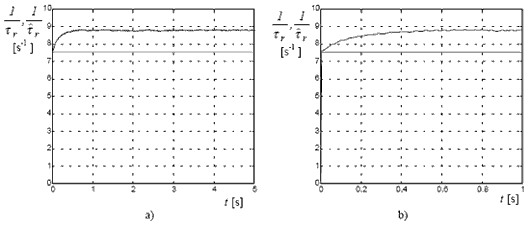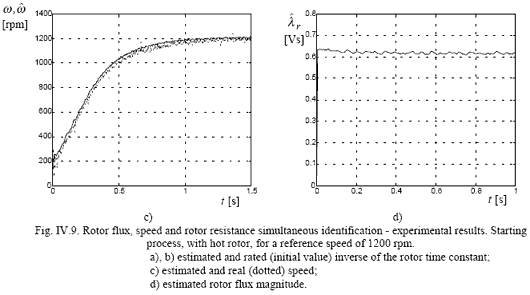Ссылки
Отчет о поиске
Автореферат
Библиотека
О Мальте
Кафедра
Факультет
ДонНТУ
Polytechnic University of Bucharest, Romania Department of Electrical Engineering
Constantin Ilas
Real time identification of induction motor drives
PhD Thesis Compendium
Supervisor: Professor R. Magureanu
1995
IV.10. Rotor Flux, Speed and Rotor Resistance Simultaneous Identification
This problem appears in sensorless drives, when the estimation and the control errors given by the rotor resistance variations are to be compensated. In this situation the flux observer will be an adaptive one, with two adapted parameters: speed and rotor resistance (more precisely the inverse of the rotor time constant). The same solution based on a Luenberger state observer is considered. The adaptation mechanisms are given by (IV.2.), for speed, and by (IV.3.) for the inverse of the rotor time constant.
As it is known [39], [46], [54] these quantities can not be simultaneously identified, no matter what method is used. We will show that for the examined solution this is because the persistent excitation condition is not respected. As it is known [18] in an adaptation law:![As it is known [18] in an adaptation law](art5_01.gif) input u must be persistent. In our case, we may write in a compact manner:
input u must be persistent. In our case, we may write in a compact manner:

Thus, we must check if the input [u1 u2] is a persistent excitation. A signal propriety of being persistent excitation is kept no matter in what reference frame it is expressed [17]. In the rotor flux reference frame this input becomes:

If the flux magnitude is constant:

Clearly one can not estimate two distinct parameters using adaptation mechanisms that are equivalent, up to a constant (for constant rotor flux magnitude).
To eliminate this fact, usually [39], [40] one or two sinusoidal components are added to the reference current on the flux loop idse*. They have low frequencies and very small magnitude in respect to the magnetizing current. By doing like this, the next experimental results have been obtained:


Part V: General Conclusions
The thesis was meant to be an unitary approach to state and parameter identification in induction motor drives. Using the theoretical analyze, simulations and experiments, it tried to summarize and compare the most important on the methods proposed during the last 5 years. The main methods for rotor flux, mechanical parameters and load torque estimation were compared and classified. In the area of state and parameter simultaneous identification a general adaptation mechanism, valid for all the solutions based on a reference model, was introduced. Four of the most used solutions for sensorless drives were discussed and compared. For every problem, the solution found optimal in respect with performance vs. complexity ratio was implemented on the DSP system and experimentally tested.
In this way we tried to facilitate the industrial application of the latest ideas proposed in the field of motion control with induction motors. This is favored by the continuos improvement of DSP performance vs. price ratio and by the great flexibility of the new digital drive systems, that allow the application of various control and identification schemes by simply changing the software.
Practical application of the thesis results would lead to the following benefits:
- enlargement of the speed range in FOC drives using the measured velocity. This is done by the improvement in flux estimation, for DFOC, and by the possibility of using a high performance hybrid control, with adaptive IFOC at low speed;
- increase of dynamic performance in systems with important variations of mechanical parameters, by using an adaptive control based on these parameters identification;
- the sensorless DFOC drives have the same dynamic and steady state performance as classical systems, in a narrower speed range, but with a lot of advantages:
- cost reduction;
- more robust systems;
- simpler mechanic setup and maintenance;
- lower noise sensitivity;
- possibility of using motors with only one shaft extremity available.
There are two general approaches to state and parameter identification in induction motor drives: the Kalman filter, and the linear state observer (Luenberger) plus an adaptation mechanism. For each problem there are also some particular solutions, based not on a general theory, but on solving various specific equation.
Theoretical analyze, numerous simulations and experiments show in every case the superiority of general solutions on those called ‘particular’. From these two general solutions, the one based on a linear state observer was chosen, because it is much simpler and demands a considerably smaller computation time than a Kalman filter, while their performance is very close. This observer is completed by an adaptation mechanism (for electrical parameters identification) and possible by a least square algorithm (for mechanical parameters identification). This solution was improved (in simplicity, reliability and computation time reduction) for an industrial implementation. The results obtained justify such an extension and show that further work should be done in the following directions:
- of enhancing the observer behavior at very low velocity, for an extra enlargement of DFOC and sensorless systems speed range. This can be done by increasing the PWM frequency. Other interesting possibility is to compute the value of voltage first harmonic by knowing the DC voltage and the transistors commutation moments;
- of expanding the area of reliable behavior of the mechanical parameters identification method to systems with slow dynamic. This can be done by improving the velocity measurement and filtering process and by finding a possibility for the variable instruments method to be used. For this, a proper instrument vector, uncorellated to model residuals has to be constructed;
- of increasing the observer robustness to motor resistances and inductances variation. The observer utilized in the thesis is quite robust to resistances variations, but it was not enough tested neither to inductances variations, nor for motors of higher power (it is known that for these motors the flux observers can be more sensitive to parameter variations). Because to correct this sensitivity by estimating the parameters is a very difficult problem, a reasonable solution is to increase their robustness. Theoretically this is a very interesting problem, implying the use of H ? techniques for a system with variable parameters (others than those for which we try to grow observer robustness, we refer to the motor speed);
- of finding an optimal configuration to the digital control system for drives using such identification and control techniques. It seems that a system with a microcontroller for analogic interface and computations related to field orientation, current loops, and so on, plus a floated (possible fixed) point DSP for implementing the sophisticated identification and control algorithms. This is, of course, valid for the present moment when there are not on the market microcontrollers powerful enough to be compared to DSPs.
Автобиография | Ссылки | Отчет о поиске | Автореферат | Библиотека | О Мальте